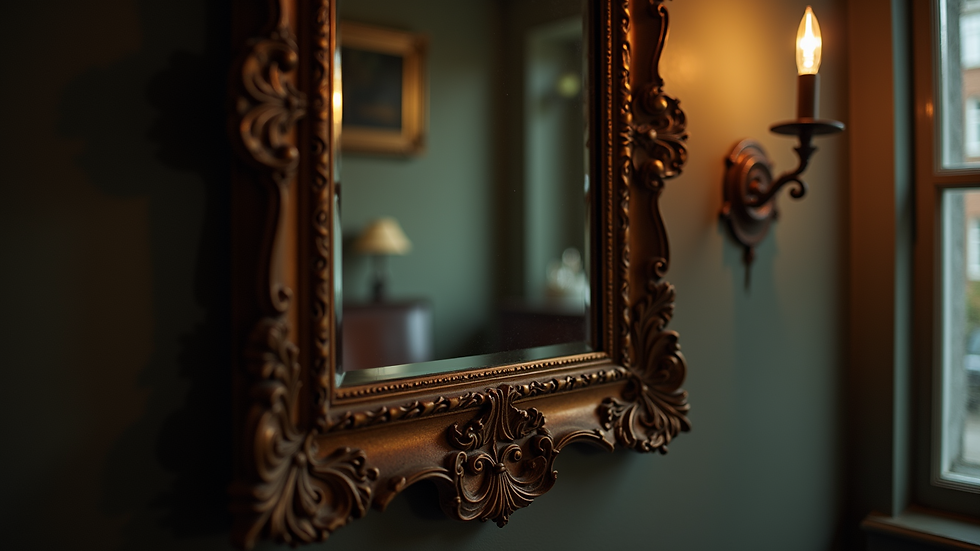Reflections of Fear: The Enigmatic Mirror Traditions on Halloween Night
- Ash Brown

- Oct 25
- 4 min read
As the clock strikes midnight on Halloween, a shiver runs down the spine of those who dare to gaze into a mirror. This night, steeped in superstition and folklore, transforms ordinary reflections into portals of the unknown. The tradition of using mirrors on Halloween is as old as the holiday itself, intertwining with themes of fear, the supernatural, and the quest for knowledge about the afterlife. In this blog post, we will explore the fascinating history and customs surrounding mirrors on Halloween night, and why they continue to captivate our imaginations.
The Origins of Mirror Traditions
The use of mirrors in Halloween traditions can be traced back to ancient cultures that believed mirrors held mystical properties. In many societies, mirrors were thought to be gateways to other realms, allowing spirits to cross over into the living world. The ancient Romans, for instance, would use mirrors during their celebrations of the dead, believing that they could communicate with lost loved ones.
As Halloween evolved, so did the customs surrounding mirrors. In the Middle Ages, it was common for people to look into mirrors at midnight on Halloween to catch a glimpse of their future spouse. This practice was rooted in the belief that the reflection would reveal not only the face of their beloved but also their fate. Such traditions have persisted, morphing into modern-day rituals that still evoke a sense of mystery and intrigue.
The Midnight Ritual
One of the most popular Halloween mirror traditions involves the act of gazing into a mirror at the stroke of midnight. This ritual is often accompanied by specific incantations or prayers, intended to summon spirits or reveal hidden truths. The atmosphere is typically charged with anticipation, as participants gather in dimly lit rooms, their hearts racing with excitement and fear.

The ritual often requires participants to be alone, as it is believed that the presence of others can disrupt the connection to the spirit world. As the clock ticks closer to midnight, the air thickens with tension, and the mirror becomes a focal point of both fear and fascination. What will be revealed? Will the spirits respond? These questions linger in the minds of those brave enough to partake in the ritual.
The Symbolism of Mirrors
Mirrors have long been associated with duality and reflection, serving as symbols of both truth and deception. On Halloween, this symbolism takes on a darker tone, as mirrors are seen as portals to the unknown. The act of looking into a mirror at midnight can evoke feelings of vulnerability, as participants confront their own fears and insecurities.
In many cultures, mirrors are also believed to trap spirits. This belief adds an extra layer of intrigue to the Halloween mirror tradition, as participants wonder if they are merely gazing at their own reflection or if something more sinister lurks behind the glass. The fear of what lies beyond the surface is a powerful motivator for those who engage in this ritual.
Modern Interpretations
In contemporary society, the tradition of using mirrors on Halloween has evolved, but its core elements remain intact. Many people still participate in the midnight mirror ritual, often sharing their experiences on social media or in storytelling circles. The allure of the unknown continues to draw individuals to this practice, as they seek to connect with the supernatural and explore their own fears.
Additionally, mirrors have found their way into Halloween decorations and haunted house attractions. From spooky mirror mazes to haunted reflections, the symbolism of mirrors is woven into the fabric of modern Halloween celebrations. These interpretations serve to remind us of the age-old traditions that continue to shape our understanding of fear and the supernatural.
The Psychological Aspect of Fear
The fascination with mirrors on Halloween also taps into the psychological aspects of fear. The act of confronting one's reflection can be a metaphor for facing inner demons and unresolved issues. As individuals peer into the mirror, they may be forced to confront aspects of themselves they would rather ignore.
This psychological dimension adds depth to the Halloween mirror tradition, transforming it from a simple ritual into a profound exploration of self. The fear that arises from gazing into the mirror is not just about the potential for encountering spirits; it is also about the fear of self-discovery and the unknown aspects of our own identities.
Conclusion
As Halloween approaches, the tradition of gazing into a mirror at midnight remains a captivating practice steeped in history and symbolism. From ancient rituals to modern interpretations, mirrors continue to serve as portals to the unknown, inviting us to confront our fears and explore the mysteries of life and death. Whether you choose to partake in this tradition or simply reflect on its significance, the enigmatic allure of mirrors on Halloween night is sure to leave a lasting impression.
So, as the witching hour approaches this Halloween, consider taking a moment to gaze into the mirror. Who knows what reflections of fear and fascination await you? Embrace the mystery, and let the spirits guide you through the shadows of the night.




























Comments